Physical Address
304 North Cardinal St.
Dorchester Center, MA 02124
This chapter discusses a heterogeneous group of benign tumors or pseudotumors, many of which are characterized by abundant myxoid stroma (intramuscular myxoma, juxta-articular myxoma, cutaneous myxoma, ganglion). Evidence indicates that the cells in these lesions are fibroblastic or have some features of myofibroblasts.
Tumoral calcinosis is a distinct clinical and histologic entity characterized by tumorlike periarticular deposits of calcium hydroxyapatite that are found mainly in the regions of the hip, shoulder, and elbow. The disorder occurs predominantly in otherwise healthy children, adolescents, and young adults; is more often multiple than solitary; and can affect two or more siblings of the same family. Unlike similar calcifications associated with renal insufficiency, hypervitaminosis D, and milk-alkali syndrome, there are no demonstrable abnormalities in calcium metabolism.
The term tumoral calcinosis was coined by Inclan in 1943, but this condition was recognized as an entity much earlier. In 1899, Duret observed this process in siblings, a 17-year-old girl and her younger brother, who had multiple calcifications in the vicinity of the hip and elbow joint. Later, in 1935, Teutschlaender gave a detailed account of another typical case, an 11-year-old girl with multiple lesions in the shoulder and elbow regions that had onset at age 2 years. He thought this process was secondary to fat necrosis and used the term lipid calcinosis . Since these descriptions, numerous other acceptable examples of this growth have been reported under various names, including calcifying bursitis , calcareous tendinitis , and “Kikuyu bursa.” In New Guinea, the natives aptly refer to it as “hip stones.”
There are essentially three forms of tumoral calcinosis ( Fig. 31.1 ): sporadic, familial, and secondary. Most common is the sporadic ( nonfamilial ) and idiopathic form, with onset during the first and second decades of life and rare in patients older than 50. It affects whites and blacks about equally, and there is a slight female preponderance. Most patients present with a solitary large, firm, subcutaneous calcified mass that is slowly growing and usually asymptomatic, typically located in the vicinity of a large joint, especially the trochanteric and gluteal regions of the hip and the lateral portion of the shoulder and the posterior elbow ( Table 31.1 ). The lesion is firmly attached to the underlying fascia, muscle, or tendon and may even infiltrate these structures, but it is unrelated to bone, and the underlying joints are unaffected. Most of these patients are in otherwise good health.
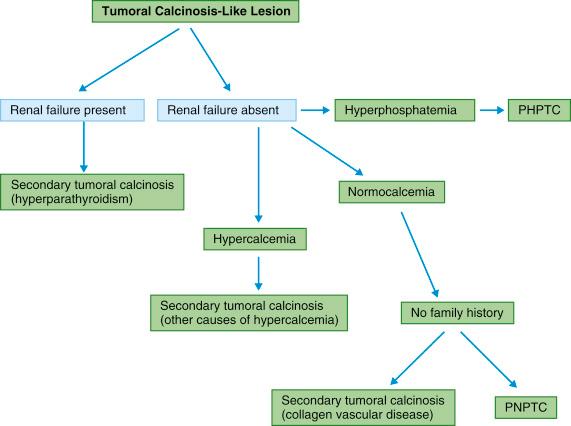
| Site | No. of Cases | Percentage (%) |
|---|---|---|
| Hips | 33 | 31 |
| Buttocks | 27 | 26 |
| Upper extremities | 16 | 15 |
| Lower extremities | 12 | 11 |
| Spine/sacrum | 7 | 7 |
| Miscellaneous | 10 | 10 |
| TOTAL | 105 | 100 |
The familial form of tumoral calcinosis has two variants, hyperphosphatemic and normophosphatemic, both inherited in an autosomal recessive manner but characterized by distinct genetic mutations. The hyperphosphatemic form, which appears to lie on a spectrum with the so-called hyperostosis-hyperphosphatemic syndrome, is characterized by mutations in GALNT3 , FGF23 , or the KL gene. Biallelic mutations in GALNT3 prevent degradation of the phosphaturic hormone fibroblast growth factor 23 (FGF23), but defective function of any of these three genes results in hyperphosphatemia and ectopic calcifications. In contrast, the normophosphatemic variant is associated with absence of functional SAMD9 , a putative tumor suppressor gene.
Both hereditary forms of tumoral calcinosis have a predilection for young males, especially African Americans. These patients characteristically have elevation of serum phosphate and vitamin D, unless they have the normophosphatemic variant. The lesions are often multifocal and may be associated with a number of other bony abnormalities, including calcifications in the shaft of long bones and cranium as well as ocular and dental abnormalities.
There is also a secondary form of tumoral calcinosis resulting from conditions that promote ectopic calcifications. This encompasses a wide range of disorders, including chronic renal failure (typically associated with secondary hyperparathyroidism), systemic sclerosis, sarcoidosis, and primary hyperparathyroidism. A history of trauma is also often elicited, particularly in those cases presenting in the distal extremities. Treatment of the calcific lesions is best done by treating the underlying disorder.
Radiographic, CT, and MRI examination reveals a subcutaneous conglomerate of multiple, rounded opacities separated by radiolucent lines (fibrous septa) imparting a chicken-wire pattern of lucencies with distinct fluid levels in some of the nodules ( Figs. 31.2 and 31.3 ). Despite the large amounts of calcium in these lesions in patients with idiopathic tumoral calcinosis, there is no evidence of osteoporosis in the skeleton, as seen in patients with renal insufficiency and secondary hyperparathyroidism.
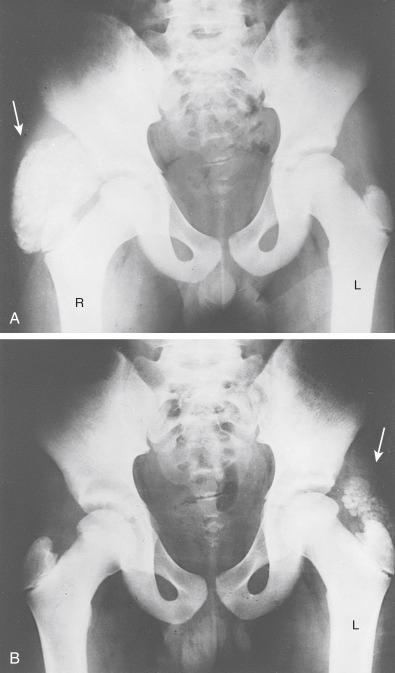
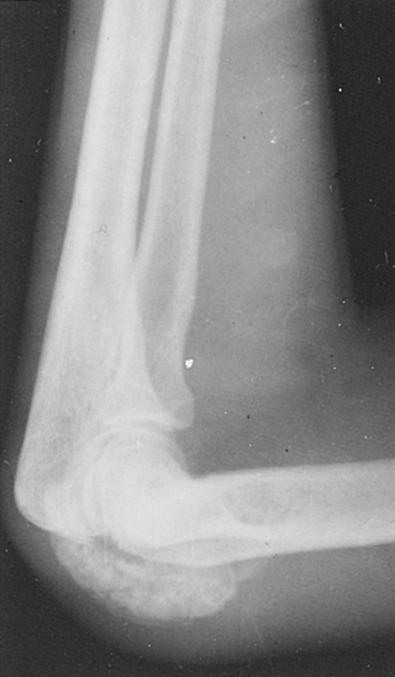
Study of the gross specimen discloses a firm, rubbery mass that is unencapsulated, extends into the adjacent muscles and tendons, and is usually 5 to 15 cm in greatest diameter. On sectioning, the mass consists of a framework of dense fibrous tissue containing spaces filled with yellow-gray, pasty, calcareous material or chalky, milky liquid that is easily washed out, resulting in irregular cystic cavities.
Microscopically, active and inactive phases of the disease can be distinguished, often coexisting in the same lesion ( Figs. 31.4 and 31.5 ). Slavin et al. proposed a three-stage classification scheme to describe these lesions, spanning from cellular examples devoid of calcification to cellular cystic lesions with calcification to hypocellular calcified lesions. In the active (cellular) phase, a central mass of amorphous or granular calcified material is bordered by a florid proliferation of mononucleated or multinucleated macrophages, osteoclast-like giant cells, fibroblasts, and chronic inflammatory elements. Fibrohistiocytic nodules may be seen during the early proliferative phase and are characterized by fibroblast-like cells, foamy histiocytes, occasional multinucleated macrophages, and hemosiderin-laden macrophages. During the inactive phase, there is merely calcified material surrounded by dense fibrous material extending into the adjacent tissues, or a cystic space surrounded by calcium deposits.
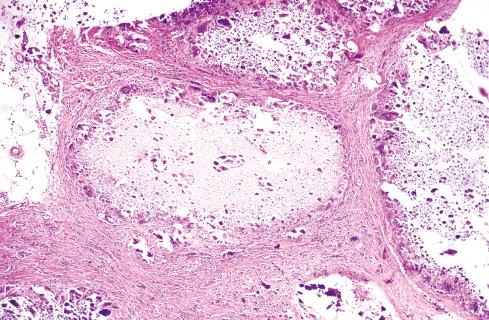
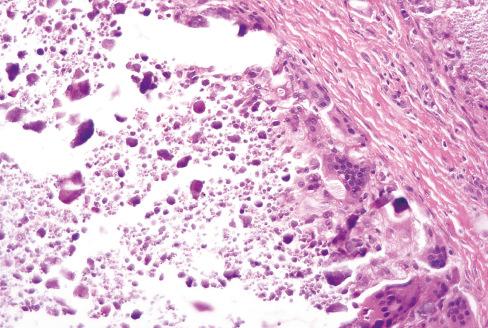
Morphologically, the lesions of tumoral calcinosis are identical regardless of whether they are idiopathic, familial, or secondary. Patients with chronic renal disease and secondary hyperparathyroidism are usually older than those with idiopathic tumoral calcinosis, have additional calcifications in visceral organs (e.g., kidney, lung, heart, stomach), and may have abnormally low calcium levels. Similar calcifying soft tissue lesions, but associated with hypercalcemia, occur in patients with primary hyperparathyroidism and milk-alkali syndrome (Burnett syndrome), a rare condition associated with prolonged antacid therapy for peptic ulcer. Patients with excessive osteolysis and mobilization of calcium in destructive neoplastic and infectious process of bone may also develop lesions that can resemble tumoral calcinosis. Laskin et al. described a group of tumoral calcinosis–like lesions that arise in an acral location and are smaller in size and seem to be pathogenetically distinct from tumoral calcinosis. In all these lesions, a detailed clinical history and laboratory data aid in reaching a reliable diagnosis. Some of these cases could represent “tenosynovitis with psammomatous calcifications.” This lesion arises in the distal extremities, predominantly the fingers and toes, mostly in young to middle-aged females, possibly secondary to trauma or repetitive injury. Histologically, the lesion shows tendinous degeneration associated with psammomatous calcifications and a histiocyte-rich infiltrate.
Calcinosis cutis universalis and calcinosis cutis circumscripta likewise are located in the skin and subcutis and are associated with normal serum calcium and phosphorus levels. Calcinosis universalis forms multiple nodules or plaques mainly in children and in about half the cases associated with manifestations of scleroderma, systemic lupus erythematosus, or dermatomyositis. It may ultimately lead to limited mobility, contractures, and ankylosis. Calcinosis circumscripta , on the other hand, chiefly affects middle-aged women and typically involves the hand and wrist, including tendon sheaths. It is associated in a large percentage of cases with Raynaud disease or scleroderma, sclerodactyly, or polymyositis. A related condition is CREST syndrome (calcinosis cutis, Raynaud phenomenon, esophageal hypomotility, sclerodactyly, telangiectasia).
There are also dystrophic calcifications, as in calcareous tendinitis or tenosynovitis, that show a similar microscopic picture but are smaller and develop in damaged tissue secondary to minor injury, ischemic necrosis, or a necrotizing infectious process. Calcifications of tendons and ligaments have also been reported in patients undergoing long-term therapy with etretinate, a synthetic vitamin A derivative prescribed for acne, psoriasis, and various keratinization disorders. Other forms of calcification, such as those of the scrotal skin, are not uncommon, but the exact cause is not clear.
Although there are different familial and nonfamilial causes of tumoral calcinosis, the constellation of histologic features is fairly consistent. The largest study in the literature, by Pakasa and Kalengayi, encompassed patients with familial, idiopathic, and secondary tumoral calcinosis, and therefore the observations are not restricted to a single entity. Minor repeated trauma and tissue injury seem to play a role in the calcifying process in some cases, serving as a trigger mechanism in genetically susceptible individuals, leading to a chain of events that begins with hemorrhage, fat necrosis, fibrosis, and collagenization and ends with collagenolysis and ultimately calcification.
For familial and idiopathic lesions, surgical excision is the treatment of choice. Although the majority of patients with idiopathic lesions are cured, familial lesions have a propensity to recur locally. Medical therapies have included intravenous sodium thiosulfate (effective for calciphylaxis related to end-stage renal disease), with limited success. Treatment of the underlying systemic cause in patients with secondary tumoral calcinosis is critical for effective management.
A dizzying array of benign mesenchymal lesions are characterized by abundant myxoid matrix, inconspicuous stellate- or spindle-shaped cells, and a poorly developed vascular pattern. Most are composed of modified fibroblasts that produce excessive amounts of glycosaminoglycans rich in hyaluronic acid and with little collagen. Intramuscular myxoma, a benign mesenchymal lesion, is of particular importance because it is almost always cured by local excision yet is easily mistaken for a low-grade myxoid sarcoma.
Become a Clinical Tree membership for Full access and enjoy Unlimited articles
If you are a member. Log in here